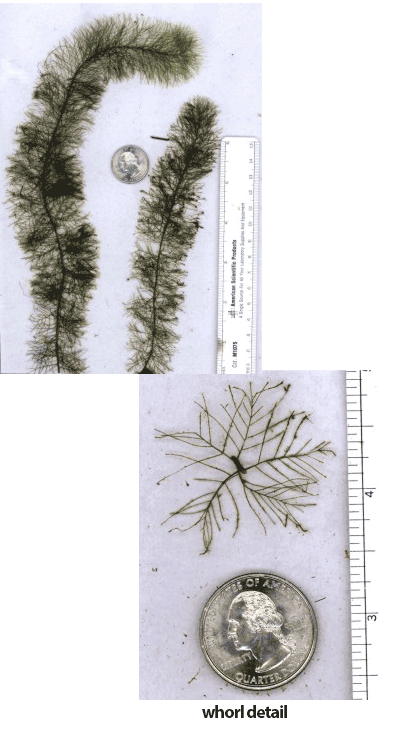Submerged Aquatic Vegetation (SAV) Identification Key
Main_Content
The bay grass key was designed to allow you to identify most species of bay grasses found in Maryland. Although bay grasses are notoriously difficult to identify using standard taxonomic keys, the flexible format of the Internet allows us to combine detailed pictures, simple line drawings and text messages in a stepwise sequence that makes identifying bay grasses simple. You may find it useful to have a clear metric ruler with millimeters marked, a magnifying glass, and a Ziploc plastic bag to help you in the process of identifying your plant.

|
If you already know the identity of a particular bay grass use the drop down boxes below. |
|---|
Common Name:
or
Scientific Name:
| | Common Name: | Low Watermilfoil |
| | Scientific Name: | Myriophyllum humile |
| | Native or Non-native: | Native
|
| | Illustration: | 
|
| | Link to larger illustration: | |
| | Printable Version: | |
| | Family: | Haloragaceae |
| | Distribution: | Native to Chesapeake Bay, but rare. Found mostly in the shallow waters of coastal ponds and reservoirs. The plant also tends to grow better in more acidic waters. |
| | Recognition: | Plant stems are very leafy, and stay submersed in the water. Leaves usually in whorls of 5 (mostly subopposite or scattered), all alike, 1-2.5 cm long with 6-10 hair-like segments per side. The leaves themselves are very slender and skinny, and make feather-looking groups. The stem of the plant can sometimes take on a reddish appearance, and sometimes the leaves can get this color as well, instead of their usual green appearance. |
| | Ecological Significance: | Just like Eurasian Watermilfoil, Low Watermilfoil can provide habitat for small organisms, such as young fish and small invertebrates, in the ponds and reservoirs that it inhabits. |
| | Similar Species: | Coontail (coarse, roughly divided leaves), and Eurasian Watermilfoil. The difference between Eurasian Watermilfoil and Low Watermilfoil is that Eurasian Watermilfoil only has whorls of 4. |
| | Reproduction: | Sexual reproduction through seeding, and asexual reproduction through fragmentation, where a portion of the plant breaks off and continues to grow as a new plant.
|
|
|
Center_Content
For permission to reproduce individual photos, please contact Mike Naylor
The text and photos used in this key were produced through a collaborative effort among the following partners.

